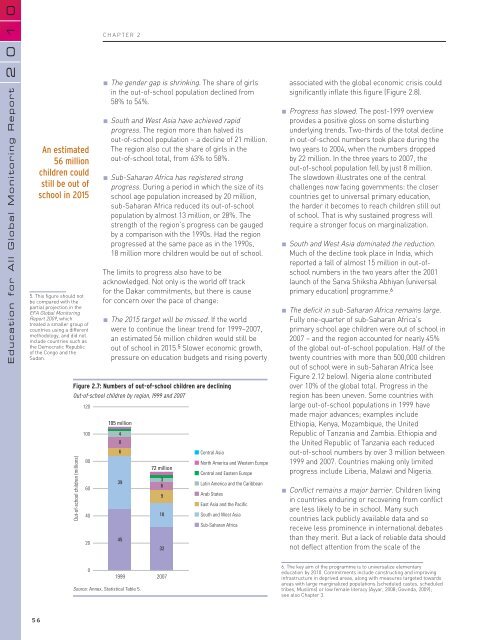Chapter 2. Progress towards the EFA goals - Unesco
Chapter 2. Progress towards the EFA goals - Unesco
Chapter 2. Progress towards the EFA goals - Unesco
Create successful ePaper yourself
Turn your PDF publications into a flip-book with our unique Google optimized e-Paper software.
0<br />
1<br />
CHAPTER 2<br />
0<br />
2<br />
Education for All Global Monitoring Report<br />
An estimated<br />
56 million<br />
children could<br />
still be out of<br />
school in 2015<br />
5. This figure should not<br />
be compared with <strong>the</strong><br />
partial projection in <strong>the</strong><br />
<strong>EFA</strong> Global Monitoring<br />
Report 2009, which<br />
treated a smaller group of<br />
countries using a different<br />
methodology, and did not<br />
include countries such as<br />
<strong>the</strong> Democratic Republic<br />
of <strong>the</strong> Congo and <strong>the</strong><br />
Sudan.<br />
The gender gap is shrinking. The share of girls<br />
in <strong>the</strong> out-of-school population declined from<br />
58% to 54%.<br />
South and West Asia have achieved rapid<br />
progress. The region more than halved its<br />
out-of-school population – a decline of 21 million.<br />
The region also cut <strong>the</strong> share of girls in <strong>the</strong><br />
out-of-school total, from 63% to 58%.<br />
Sub-Saharan Africa has registered strong<br />
progress. During a period in which <strong>the</strong> size of its<br />
school age population increased by 20 million,<br />
sub-Saharan Africa reduced its out-of-school<br />
population by almost 13 million, or 28%. The<br />
strength of <strong>the</strong> region’s progress can be gauged<br />
by a comparison with <strong>the</strong> 1990s. Had <strong>the</strong> region<br />
progressed at <strong>the</strong> same pace as in <strong>the</strong> 1990s,<br />
18 million more children would be out of school.<br />
The limits to progress also have to be<br />
acknowledged. Not only is <strong>the</strong> world off track<br />
for <strong>the</strong> Dakar commitments, but <strong>the</strong>re is cause<br />
for concern over <strong>the</strong> pace of change:<br />
The 2015 target will be missed. If <strong>the</strong> world<br />
were to continue <strong>the</strong> linear trend for 1999–2007,<br />
an estimated 56 million children would still be<br />
out of school in 2015. 5 Slower economic growth,<br />
pressure on education budgets and rising poverty<br />
Figure <strong>2.</strong>7: Numbers of out-of-school children are declining<br />
Out-of-school children by region, 1999 and 2007<br />
Out-of-school children (millions)<br />
120<br />
100<br />
80<br />
60<br />
40<br />
20<br />
105 million<br />
4<br />
8<br />
6<br />
39<br />
45<br />
72 million<br />
3<br />
6<br />
9<br />
18<br />
32<br />
Central Asia<br />
North America and Western Europe<br />
Central and Eastern Europe<br />
Latin America and <strong>the</strong> Caribbean<br />
Arab States<br />
East Asia and <strong>the</strong> Pacific<br />
South and West Asia<br />
Sub-Saharan Africa<br />
associated with <strong>the</strong> global economic crisis could<br />
significantly inflate this figure (Figure <strong>2.</strong>8).<br />
<strong>Progress</strong> has slowed. The post-1999 overview<br />
provides a positive gloss on some disturbing<br />
underlying trends. Two-thirds of <strong>the</strong> total decline<br />
in out-of-school numbers took place during <strong>the</strong><br />
two years to 2004, when <strong>the</strong> numbers dropped<br />
by 22 million. In <strong>the</strong> three years to 2007, <strong>the</strong><br />
out-of-school population fell by just 8 million.<br />
The slowdown illustrates one of <strong>the</strong> central<br />
challenges now facing governments: <strong>the</strong> closer<br />
countries get to universal primary education,<br />
<strong>the</strong> harder it becomes to reach children still out<br />
of school. That is why sustained progress will<br />
require a stronger focus on marginalization.<br />
South and West Asia dominated <strong>the</strong> reduction.<br />
Much of <strong>the</strong> decline took place in India, which<br />
reported a fall of almost 15 million in out-ofschool<br />
numbers in <strong>the</strong> two years after <strong>the</strong> 2001<br />
launch of <strong>the</strong> Sarva Shiksha Abhiyan (universal<br />
primary education) programme. 6<br />
The deficit in sub-Saharan Africa remains large.<br />
Fully one-quarter of sub-Saharan Africa’s<br />
primary school age children were out of school in<br />
2007 – and <strong>the</strong> region accounted for nearly 45%<br />
of <strong>the</strong> global out-of-school population. Half of <strong>the</strong><br />
twenty countries with more than 500,000 children<br />
out of school were in sub-Saharan Africa (see<br />
Figure <strong>2.</strong>12 below). Nigeria alone contributed<br />
over 10% of <strong>the</strong> global total. <strong>Progress</strong> in <strong>the</strong><br />
region has been uneven. Some countries with<br />
large out-of-school populations in 1999 have<br />
made major advances; examples include<br />
Ethiopia, Kenya, Mozambique, <strong>the</strong> United<br />
Republic of Tanzania and Zambia. Ethiopia and<br />
<strong>the</strong> United Republic of Tanzania each reduced<br />
out-of-school numbers by over 3 million between<br />
1999 and 2007. Countries making only limited<br />
progress include Liberia, Malawi and Nigeria.<br />
Conflict remains a major barrier. Children living<br />
in countries enduring or recovering from conflict<br />
are less likely to be in school. Many such<br />
countries lack publicly available data and so<br />
receive less prominence in international debates<br />
than <strong>the</strong>y merit. But a lack of reliable data should<br />
not deflect attention from <strong>the</strong> scale of <strong>the</strong><br />
0<br />
1999 2007<br />
Source: Annex, Statistical Table 5.<br />
6. The key aim of <strong>the</strong> programme is to universalize elementary<br />
education by 2010. Commitments include constructing and improving<br />
infrastructure in deprived areas, along with measures targeted <strong>towards</strong><br />
areas with large marginalized populations (scheduled castes, scheduled<br />
tribes, Muslims) or low female literacy (Ayyar, 2008; Govinda, 2009);<br />
see also <strong>Chapter</strong> 3.<br />
56
















